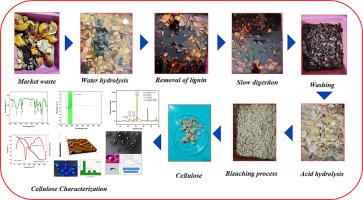Isolation of microcrystalline cellulose from vegetable waste biomass and its potential as a high-performance green reinforcement in biocomposites
Q1 Environmental Science
引用次数: 0
Abstract
Global problems on waste disposal and sustainable material production require an innovative concept for recycling and utilization of waste materials. This work was centred toward isolation and comprehensively characterizing of microcrystalline cellulose from a market waste. High purity microcrystalline cellulose was obtained through a chemical process that uses tetraethylenetetramine, tartaric acid, sulfamic acid and sodium percarbonate in sequence. The extracted microcrystalline cellulose had a yield of 38 %, density of 1.491 g/cm3 and an impressive cellulose content of 95.19 %. Characterization analysis such as Fourier-transform infrared spectroscopy, X-ray diffractometer, ultraviolet-visible spectroscopy, thermal analysis, and morphological analysis showed that the synthesized material was highly crystalline with crystallinity index of 73.8 % and average particle size of 103.696 μm. The microcrystalline cellulose had a good thermal stability with a thermal degradation temperature of 228.56 °C and energy of activation of 74.16 kJ/mol. The scanning electron microscopy analysis revealed a rough and porous surface with distinct crystal bundles and average particle size of 103.696 μm which were beneficial in improving interfacial adhesion in composites. Additional surface roughness parameters determined by atomic force microscopy scans yielded negative skewness values, and higher kurtosis to support the material's applicability for mechanical reinforcement. The findings revealed that the microcrystalline cellulose derived from agricultural waste disposal was a sustainable and effective reinforcement for advanced composites. In addition, the microcrystalline cellulose supports the circular bioeconomy and achievement of sustainable development goal (SDG 12) established by the United Nations in 2015, which focuses on responsible consumption and production.

从植物废弃物中分离微晶纤维素及其在生物复合材料中作为高性能绿色增强材料的潜力
关于废物处理和可持续材料生产的全球性问题要求对废物的回收和利用有一个创新的概念。这项工作集中于从市场废物中分离和全面表征微晶纤维素。采用四乙基四胺、酒石酸、氨基磺酸、过碳酸钠等化学工艺,制备了高纯度微晶纤维素。提取的微晶纤维素产率为38%,密度为1.491 g/cm3,纤维素含量为95.19%。傅里叶变换红外光谱、x射线衍射、紫外可见光谱、热分析和形态分析等表征分析表明,合成的材料结晶度高,结晶度指数为73.8%,平均粒径为103.696 μm。微晶纤维素具有良好的热稳定性,热降解温度为228.56℃,活化能为74.16 kJ/mol。扫描电镜分析表明,复合材料表面粗糙多孔,晶束清晰,平均粒径为103.696 μm,有利于提高复合材料的界面附着力。通过原子力显微镜扫描确定的其他表面粗糙度参数产生负偏度值和更高的峰度,以支持材料用于机械加固的适用性。研究结果表明,从农业废弃物处理中提取的微晶纤维素是一种可持续的、有效的复合材料增强剂。此外,微晶纤维素支持循环生物经济和实现联合国于2015年制定的可持续发展目标(SDG 12),该目标侧重于负责任的消费和生产。
本文章由计算机程序翻译,如有差异,请以英文原文为准。
求助全文
约1分钟内获得全文
求助全文
来源期刊

Bioresource Technology Reports
Environmental Science-Environmental Engineering
CiteScore
7.20
自引率
0.00%
发文量
390
审稿时长
28 days
 求助内容:
求助内容: 应助结果提醒方式:
应助结果提醒方式:


